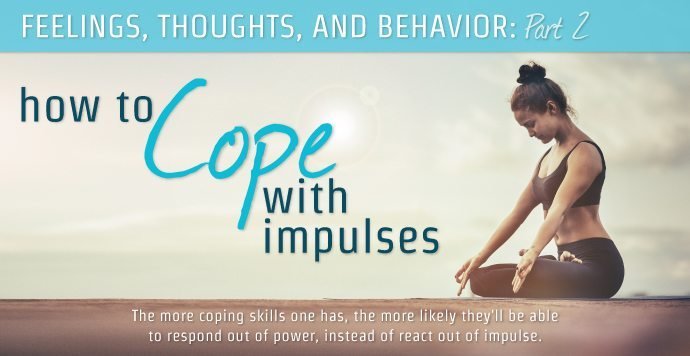Feelings, Thoughts, And Behavior: How To Cope With Impulses: Part 2

In this article, we will continue to explore how to cope with impulsive behavior regarding our thoughts, feelings, impulses, and behaviors with examples of two situations – Jerry and Alicia.
In all situations, the ability to interrupt an impulse is best done immediately – first with emotion and then with thought. There is a continuum of time in which to interrupt this impulse before it goes into the mode of action or behavior (although for people who are very impulsive, they need to interrupt that process immediately or they will quickly go into the territory of problematic behavior).
A Continuum Of Thoughts/Feelings/Behaviors:

As we look at this diagram, we will examine two scenarios that explain how this works. The first scenario involves relapsing on alcohol and the second scenario is about self-harm behaviors.
Jerry
For the first scenario we’ll explore Jerry’s response to being sober. Jerry completed a residential AOD (alcohol and other drugs) treatment program, has been sober for 12 months, and is quite pleased with himself for staying sober. It has been a good year and he’s feeling happy with this accomplishment. He has a new job which he enjoys and even though he got divorced due to his drinking, he gets along with his ex-wife and sees his kids frequently. He has just begun dating and feels more positive about himself than he has in years.
Today, Jerry needs to run some errands, so he heads off to the grocery store. He’s feeling in a celebratory mood and is thinking about getting a beer, because, as he sees it, he has proven to himself that he can stay sober. After all, one beer won’t hurt him, he thinks. He gets his cart and starts putting food into it. Normally, he doesn’t go down the alcohol aisle because it is a trigger for him, but as he justifies the celebration of being sober, he goes down that aisle.
Of course, while in the aisle, Jerry realizes that he can’t buy just one beer at this store, so he thinks he’ll get a 6-pack and he can celebrate with one beer a day. However, he sees that a case (usually 24 or more) of his favorite beer is on sale and as he thinks about what he wants to do, he decides he’ll have a party with some friends, so he gets the case. After all, he’ll just have one beer at the party and his friends can have the rest.
So Jerry adds the case of beer to his cart, finishes shopping, goes to the checkout counter, lifts his groceries and beer onto the belt, and then pays. Feeling happy about having a party, he gets in the car, drives home, and unloads his groceries and beer. He then mows his lawn, does some gardening, and cleans his garage, which takes three hours. As he recuperates by sitting on his deck, he decides to have his one beer. Since he’s so hot and tired, he thinks that he’ll have just one more beer as drinking just two beers was never a problem.
Before long, while still enjoying his drink, Jerry receives a call from his boss who tells him he messed up on an account; his boss is very angry. Jerry gets defensive about this error and as he hangs up, he is upset as well. At this point, he decides to continue drinking and ends up drinking 12 beers. Now Jerry is very drunk. He rationalizes his drinking by focusing on how he’s no longer angry and is feeling much better in his state of intoxication. And so relapse begins….
How Could Jerry Have Interrupted The Impulse To Drink?
Return to the graph above to explore when and how Jerry could have stopped this process.
Possible Interruption Points:
- He was feeling happy before drinking so he didn’t need to change his sober good mood.
- He needed to immediately interrupt the initial thought process of celebrating and getting a beer; at this point, he was already in “stinkin’ thinkin” mode and was giving himself permission to drink.
- He could have stopped himself by not going to the store or down the alcohol aisle.
- He could have stopped himself by not putting the beer into his cart.
- He could have returned the beer to the aisle before he went to check out.
- He could have gone to the checkout and told the clerk he changed his mind about the beer.
- He could have not put the beer in his car.
- He could have taken it to a friend and not home.
- He could have not taken it into the house.
- He could have taken it into the house and then poured it down the sink.
- He could have stopped himself before that first drink.
- He could have dealt with his anger towards his boss in a healthy manner instead of deciding to get drunk.
- At any time, he could have called his sponsor, sober friends, or counselor.
- At any time, he could have interrupted his feelings and thoughts and used any number of his other coping skills such as reading, exploring healthy ways to deal with the work situation, calling his girlfriend, going to a movie, or going fishing.
As is obvious to see, the longer Jerry went into this situation, the more difficult it would be to interrupt the process. By the time he was loading the beer into his cart, it was highly unlikely that he was not going to drink, although he still had plenty of time to interrupt this impulse along the way.
Alicia
For this scenario, we take a look at Alicia, who not only has addictions to crack and alcohol, but also to self-harming behaviors, primarily cutting herself. Alicia has been clean and sober for 3 months, but has struggled with her cutting and has been diagnosed with borderline personality disorder. She has been through DBT (dialectical behavioral therapy) and has a variety of skills she can utilize. She does see a therapist for her co-occurring disorders but often struggles with this relationship due to her black and white thinking.
Alicia is very impulsive and this is the longest she has ever been in recovery. However, since she has been clean and sober, the urges to self-harm have increased and she continues to give in to these urges. Today, she discovered that her beloved dog Murphy was hit by a car and died. Murphy was her best friend and this trauma has sent her into a tailspin. Her feelings are of sadness, horror, and of hate for the driver who hit her dog. She immediately thinks about getting drugs, but has nothing in the house so she decides to cut her arms as she knows this will provide some relief from the emotional pain.
Alicia goes down a mental path from emotions, thoughts, impulses, to behaviors very quickly; she has little time to interrupt the impulse to cut. Unfortunately, she keeps a razor blade in her medicine cabinet and she immediately goes to get this. She cuts her arms and is able to numb some of the emotional pain which makes the situation somewhat better. After she cuts herself, she calls her therapist to tell her about the trauma and about the cutting. As she’s bleeding fairly heavily and is suicidal, her therapist tells her to go to the emergency room, which she does. She’s assessed for suicidality and is admitted to the inpatient psychiatric unit for the fifth time in her life.
How Could Alicia Have Interrupted The Impulse To Cut Herself?
Return to the graph above to see how Alicia could have interrupted this process.
Potential Interruptions:
- Alicia could have assessed her feelings, validated them, and focused on grieving in a healthy manner.
- She could have interrupted the process by examining her thoughts of self-harm and using positive self-talk or used distraction (coping) skills to distract herself from the trauma. She could have used all the tools she learned from DBT.
- She could have called her therapist immediately and discussed her trauma, exploring ways to keep from harming herself, or contacted an emergency services program at the community mental health center she attends.
- She could have contacted her sponsor for her co-occurring disorders.
- She could have taken the razor out to the trash to keep from cutting.
- She could have called supportive friends/family to process the death with them.
- She could have utilized a variety of her coping skills such as coloring in her art book, breathing deeply to relax, journaling about the loss of her dog, or going for a walk.
- She could have contacted a grief support group.
Unfortunately, Alicia is so impulsive, she utilizes none of these skills and doesn’t even think of them until she is safely ensconced in the psychiatric unit.
In summary, both Jerry and Alicia had a variety of tools and moments to interrupt the impulse of relapse or negative behavior before participating in what furthers their disorders. The more coping skills one has, the more likely they’ll be able to respond out of power, instead of react out of impulse. We all need to have a variety of coping skills to get us through the ups and downs of our lives.
Click Here To Read Feelings, Thoughts, And Behavior: How To Cope With Impulses: Part 1




